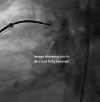Management of PDA device closure complicated by severe hemolysis by transcatheter retrieval and deployment of new device
- PMID: 36897475
- PMCID: PMC10006361
- DOI: 10.1186/s43044-023-00343-8
Management of PDA device closure complicated by severe hemolysis by transcatheter retrieval and deployment of new device
Abstract
Background: Hemolysis after Patent ductus arteriosus (PDA) device closure is rare. Although in most cases, hemolysis settles on its own; however, in some cases it may not settle spontaneously and may require additional procedures like putting additional coils, gel foam or thrombin instillation, balloon occlusion, or removing it surgically. We report a case of adult PDA device closure who persisted with hemolysis and was managed by transcatheter retrieval.
Case presentation: A 52-year-old gentleman presented to us with a diagnosis of large PDA with operable hemodynamics. Descending thoracic aortic Angio showed a large 11 mm PDA. Transcatheter device closure was done in the same sitting with a 16 × 14 Amplatzer Ductal Occluder I(ADO) device,;however, after device release, the aortic end of the device was not fully formed and there was residual flow. The next morning patient started with gross hematuria with persistent residual flow. We tried to manage with conservative means including hydration, and blood transfusion; however, residual flow persisted for 10 days and his hemoglobin dropped from 13 gm/dl preprocedural to 7 gm/dl, creatinine increased from 0.5 mg/dl to 1.9 mg/dl, bilirubin increased to 3.5 mg/dl & urine showed hemoglobinuria. As the patient continued to deteriorate it was planned to retrieve the device by transcatheter approach. 10 French amplatzer sheath was parked in the pulmonary artery near the ductus. We tried with a combination of multiple catheters and Gooseneck snare (10 mm) and finally, we successfully retrieved with a combination of Multipurpose (MP) catheter and 10 mm Gooseneck snare. After that, we closed the defect successfully with a double disk device (muscular Ventricular septal defect 14 mm Amplatzer). The patient's hematuria settled and was discharged after 2 days with normal hemoglobin and creatinine.
Conclusions: Patent ductus arteriosus ADO 1 device should not be released if the aortic end of the disk is not fully formed Patient should be carefully monitored for hemolysis if evidence of residual shunt and given supportive treatment. If conservative treatment fails, residual flow needs to be eliminated. Transcatheter retrieval although technically challenging is a feasible treatment. A muscular VSD device is a good alternative to the usual PDA device to close PDA, especially in adults.
Keywords: Amplatzer duct occluder; Catheter intervention; Hemolysis.
© 2023. The Author(s).
Conflict of interest statement
The authors declare that they have no competing interests.
Figures




References
LinkOut - more resources
Full Text Sources
Research Materials
